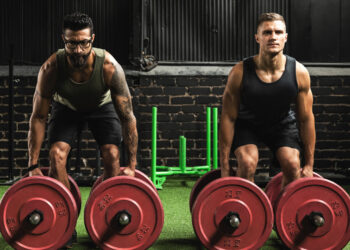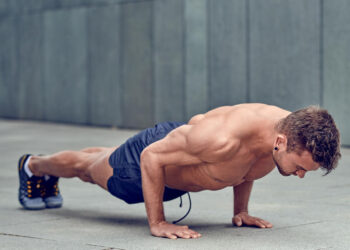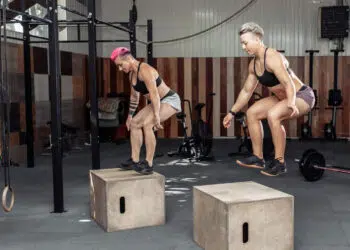One of the most important principles of successful bodybuilding is consistency. Missing workouts will severely undermine your muscle-building progress. Your body doesn’t care that you’re too busy to go to the gym or that your gym is closed; it’ll stop growing if you stop training. Miss enough workouts, and you’ll start to lose muscle.
Keep building muscle even when you can’t get to the gym with our equipment-free bodybuilding workout!
Overview
Firstly, by equipment-free, we mean that you don’t have access to barbells, dumbbells, or resistance training machines. However, you will still need somewhere to do pull-ups/chin-ups and dips, such as a power tower, a towel, and an exercise mat.
But, other than those few items, you don’t need any additional equipment for this workout, which makes it ideal for bodybuilders who train at home. You can also do this program in many parks or anywhere the calisthenic folk like to work out.
Next, remember to start every workout with a warm-up to prepare your muscles and joints for what you are about to do. 5-10 minutes of jump rope followed by some dynamic mobility and flexibility exercises will get the job done.
Finally, do each of the following workouts twice a week. There’s an upper-body workout and a lower-body workout.
Level Up Your Fitness: Join our 💪 strong community in Fitness Volt Newsletter. Get daily inspiration, expert-backed workouts, nutrition tips, the latest in strength sports, and the support you need to reach your goals. Subscribe for free!
For example:
- Monday – lower
- Tuesday – upper
- Thursday – lower
- Friday – upper
Alternatively, just use either of the workouts to fill in whenever you are unable to get to the gym.
Equipment-Free Bodybuilding Workouts
The number of reps specified for each exercise are for illustration purposes only. Depending on your fitness and body weight, you may be able to do more or less reps. Simply take each set to within 1-2 reps of failure to stimulate muscle growth.
Equipment-Free Lower Body Workout
| No: | Exercise | Sets | Reps | Recovery |
| 1 | Sissy squat | 2-4 | 12-15 | 60 seconds |
| 2 | Single-leg hip thrust | 2-4 | 10-12 | 60 seconds |
| 3 | Close stance cyclist squat | 2-4 | 15-20 | 60 seconds |
| 4 | Single-leg RDL | 2-4 | 12-15 per leg | 60 seconds |
| 5 | Step-through lunge | 2-4 | 8-10 per leg | 60 seconds |
| 6 | Single-leg calf raise | 2-4 | 15-20 per leg | 60 seconds |
| 7 | RKG plank | 2-4 | 15-20 seconds | 60 seconds |
Equipment-Free Upper Body Workout
| No: | Exercise | Sets | Reps | Recovery |
| 1 | Wide 1 ½ rep push-up | 2-4 | 12-15 | 60 seconds |
| 2 | Paused pull-up | 2-4 | 6-10 | 60 seconds |
| 3 | Chest dip | 2-4 | 10-12 | 60 seconds |
| 4 | 1 ½ chin-up | 2-4 | 6-10 | 60 seconds |
| 5 | Pike push-up | 2-4 | 10-12 | 60 seconds |
| 6 | Dynamic tension biceps curl | 2-4 | 12-15 | 60 seconds |
| 7 | Plank triceps extension | 2-4 | 8-10 | 60 seconds |
Exercise Descriptions
There are two ways to do any exercise: the right way and the wrong way. The right way keeps the stress on the target muscles and off your joints for a safe, productive workout. The wrong way is invariably easier, less effective, and could cause injuries.
Choose the right way!
Follow these instructions to make sure you get the most from our equipment-free bodybuilding workouts.
Lower Body Workout
1. Sissy squat
Sissy squats are an old-school quadriceps exercise. Contrary to their name, this is a demanding exercise that will leave your thighs burning and shaking. Because it’s such a challenging exercise, it’s ideal for bodyweight-only training.
How to do it:
- Stand in a doorway or next to a wall or post for balance. Rise up onto your tiptoes and brace your abs.
- Push your hips forward, lean back, and squat down as far as you can. Keep your body straight and try to push your knees forward and well beyond your toes.
- Drive the balls of your feet into the floor and stand back up.
- Tense your thighs at the top of each rep and repeat.
2. Single-leg hip thrust
Hip thrusts target your hamstrings and glutes. They’re generally done with a barbell, but you can also overload your muscles working one leg at a time. In fact, training unilaterally often leads to greater muscle engagement and a more effective workout.
How to do it:
- Lie on your back with your legs bent and feet flat. Brace your abs. Lift one foot off the floor and pull your knee in toward your chest. This is your starting position.
- Drive your foot into the floor and lift your hips up so that they form a straight line with your knee and shoulders.
- Lower your butt back to the floor and repeat for the prescribed number of reps.
- Change legs and do the same number of reps with the other leg.
3. Close stance cyclist squat
With no leg extension to use, you’ll need to use alternative exercises to develop your quads. Close stance cyclist squats replicate the demands of cycling. Elite cyclists often have massive, muscular thighs despite very little strength training.
How to do it:
- Place something like a thick book on the floor. Stand with your heels on the book, feet just a few inches apart. Brace your abs.
- Keeping your body as upright as possible, squat down as deep as you can but without rounding your lower back.
- Stand back up, stopping just short of full lockout to keep the tension on your quads.
- Descend again and repeat for the prescribed number of reps.
4. Single-leg RDL
Romanian deadlifts (RDLs) are an effective posterior chain exercise usually done with a barbell or dumbbells. Doing them on one leg increases muscular overload and creates instability, leading to greater glute and hamstring engagement. Single-leg RDLs are also an excellent balance and mobility exercise.
How to do it:
- Stand with your feet together. Brace your core. Shift your weight onto one leg, and bend your supporting knee slightly for balance.
- Hinging from your hips, lean forward and reach down toward the floor in front of your foot. Extend your other leg out behind you.
- Contracting your hamstrings, pull your torso upright and repeat for the required number of reps.
- Change legs and repeat on the other side.
5. Step-through lunge
Step-through lunges are a challenging lower body exercise. With several weight shifts per rep, this move really fires up your glutes, hamstrings, and quadriceps, challenging your muscles without relying on an external load. It’s also a good exercise for developing better balance.
How to do it:
- Stand tall with your feet together and your hands by your sides. Look straight ahead and not down at the floor. Brace your abs.
- Take a large step forward, bend your legs, and lower your rear knee down to within an inch of the floor.
- Push off your front leg and step back into a reverse lunge. Do not “touch down” as you move between forward to backward lunges.
- Push off your back leg and move into another forward lunge.
- That’s one rep – keep going!
- Continue for the prescribed number of reps and then swap legs.
6. Single-leg calf raise
You can’t have a leg workout without training your calves! This simple exercise provides the ideal way to overload your calves without resorting to using a machine or additional weights.
How to do it:
- Stand with one foot on the edge of a step. Use your arms for balance as required.
- Keeping your knee straight, lower your heel down below your toes and then rise up onto your tiptoes.
- Repeat for the prescribed number of reps and then change legs.
7. RKC plank
Planks are a great abs and core exercise but, for many people, they’re too easy to be effective. The RKC (Russian Kettlebell Challenge) variation is much more demanding because, instead of trying to see how long you can plank for, you focus on contracting your core muscles as hard as you can. This is both time-efficient and more effective.
Level Up Your Fitness: Join our 💪 strong community in Fitness Volt Newsletter. Get daily inspiration, expert-backed workouts, nutrition tips, the latest in strength sports, and the support you need to reach your goals. Subscribe for free!
How to do it:
- Lie on your front and rest on your elbows. Your forearms should be parallel and facing forward.
- Lift your hips, so your body forms a straight line.
- Clench your fists, contract your chest and shoulders, brace your abs, and flex your glutes and quadriceps as hard as you can.
- Without holding your breath, squeeze all these muscles as powerfully as possible for 15-20 seconds. If you can continue for longer you aren’t working hard enough!
- Relax for a moment and then repeat.
Upper Body Workout
1. Wide 1 ½ rep push-up
Push-ups are an excellent chest exercise, but the lack of external load can mean they’re too easy for more experienced exercisers. This variation is not only more demanding; it’s also more chest-centric.
How to do it:
- Squat down and place your hands on the floor so they’re a bit wider than shoulder-width apart. Your fingers should be pointing forward.
- Walk your feet out and back, so your shoulders, hips, and feet form a straight line. Brace your abs and pull your shoulders down and back.
- Bend your arms and lower your chest to within an inch of the floor.
- Extend your arms and push yourself halfway back up.
- Lower your chest to the floor again.
- Extend your arms and come all the way up.
- That’s one rep; keep going!
2. Paused pull-up
Adding a purposeful pause at the top of each pull-up rep increases lat activation while sparing your biceps. This is the perfect way to get more from every pull-up you do!
How to do it:
- Hang from your pull-up bar with an overhand, shoulder-width grip. Brace your abs and pull your shoulders down and back.
- Bend your arms, pull your chin up and over the bar, and hold this position for 2-3 seconds.
- Descend smoothly and under control, and then repeat.
3. Chest dip
Dips are a powerful chest and triceps exercise. Make them even more effective by doing chest dips with your legs extended out behind you to increase pectoral engagement.
How to do it:
- Use dipping bars that are wider than shoulder-width apart. The narrower your grip, the less chest engagement there will be.
- Place your hands on the bars with your palms turned inward. Support your weight on straight arms.
- Bend your knees and push your legs and hips as far back as you can. The greater the incline, the more pec activation there will be.
- Bend your arms and descend as far as you can without hurting your shoulders. Get a good stretch in your pecs. Allow your upper arms and elbows to flare outward.
- Extend your elbows and push yourself upward, stopping just short of lockout to keep the tension on your pecs. Push inward as well as downward to maximize pec engagement.
- Descend and repeat.
4. 1 ½ chin-up
Chin-ups use a supinated or palms-up grip, and many exercisers find them easier than overhand pull-ups. The supinated position puts your biceps in a more biomechanically favorable position. Increase time under tension and make this exercise more lat-centric by using the 1 ½ rep method.
How to do it:
- Hang from your pull-up bar with an underhand, shoulder-width grip.
- Bend your arms and pull your chin up and over the bar.
- Descend until your upper arms are roughly parallel to the floor, i.e., halfway.
- Pull your chin back up to the bar, and then descend all the way down.
- That’s one rep – continue until you cannot do any more reps.
5. Pike push-up
With no barbells or dumbbells to use, you may be wondering how you can train your shoulders. Pike push-ups closely replicate overhead presses using just your bodyweight for resistance. They’re also an excellent triceps builder.
How to do it:
- Adopt the push-up position with your hands roughly shoulder-width apart. Brace your core and pull your shoulders back.
- Keeping your legs straight, lift your butt into the air, so your body resembles an inverted V.
- Keeping your hips up, bend your arms and lower your head to within an inch of the floor.
- Push back up and repeat.
6. Dynamic tension biceps curl
While all those pull-ups and chin-ups have given your biceps a good workout, almost every bodybuilder alive wants bigger arms and also includes curls in their upper body workouts.
This equipment-free exercise overloads your arms without having to rely on a barbell or dumbbells.
How to do it:
- Hold a towel with an underhand, shoulder-width grip, just like you are about to do barbell curls.
- Tensing your biceps as hard as you can, slowly curl the towel up to your shoulders.
- Extend your arms and repeat.
- Keep your biceps tensed throughout – no relaxing!
7. Plank triceps extension
Push-up and dips are both effective triceps exercises. But, if you really want massive arms, you also need to train your triceps in isolation.
This exercise is a sort of bodyweight skull crusher. And, on the plus side, you can do them to failure without having to worry about hitting your head with a barbell!
How to do it:
- Adopt the plank position with your body straight and forearms parallel.
- Keeping your core braced, extend your elbows and push yourself back and up until your arms are straight.
- Bend your arms, lower your elbows slowly back to the floor, and then repeat.
Wrapping Up
In many ways, your body is smarter than even the most powerful computer. It can process vast volumes of information almost instantly while doing lots of other tasks at the same time.
However, in other ways, your body is not very clever at all, but that’s not necessarily a bad thing!
For example, it cannot differentiate between doing leg presses on a state-of-the-art machine in an exclusive gym and doing sissy squats in your spare room or garage. It just knows tension and movement.
So long as you work hard enough, your muscles will respond by getting bigger and stronger no matter how you overload them.
Because of this, you can maintain your bodybuilding progress with equipment-free workouts. That’s good news if you don’t have time to get to the gym or prefer to work out for free at home or at your local park.
Providing you train hard and consistently, you can build muscle almost anywhere!








